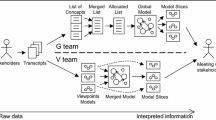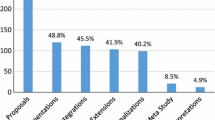Abstract
This paper argues that existing definitions of viewpoints in software engineering are inadequate for requirements engineering (RE). The ESPRIT 6353 ‘NATURE’ basic research action proposes an alternative definition which recognises that viewpoints are social artefacts within the RE process. It also proposes novel computational mechanisms for analysing different viewpoints as a basis for more informed negotiation between viewpoint owners. This paper reports important aspects of this research and outlines an agenda for future research in multiperspective RE.
Similar content being viewed by others
References
Leite JCSP, Freeman PA. Requirements validation through viewpoint resolution. IEEE Trans Software Eng, 1991; 17(12): 1253–1269
Ainsworth M, Cruicshank AH, Wallis PJ, Groves LJ. Viewpoint Specification and Z. Inform Software Technol, 1994; 36(1): 43–51
Norman DA. The psychology of everyday things. Basic Books Inc, 1988
Clement A, Van der Besselar P. A retrospective look at PD projects. Commun ACM, 1993; 36(4): 29–39
Easterbrook S. Handling conflict between domain descriptions with computer-supported negotiation. Knowledge Acquisition, 1991; 3: 255–289
Mullery GP. CORE: a method for controlling requirement ment specification. In: Proceedings of the 4th international conference on software engineering. IEEE Computer Society Press, 1979, 126–135
Kotonya G, Sommerville I. Viewpoints for requirements definition. Software Eng J, 1992; 7 (6): 375–387
Nuseibeh B, Kramer J, Finkelstein ACW. Expressing the relationship between multiple views in requirements specifications. IEEE Trans Software Eng, 1994; 20(10): 760–773
Goguen JA, Linde C. Techniques for requirements elicitation. In. Proceedings of the IEEE Symposium on RE. IEEE Computer Society Press, Los Alamitos, CA, 1993, pp 152–164
Maiden NAM, Sutcliffe AG. Exploiting reusable specifications through analogy. Commun ACM, 1992; 34(5): 55–64
Scacchi W. Managing software engineering projects: a social analysis. IEEE Trans Software Eng, 1984; 10(1): 49–59
Curtis B, Krasner H, Iscoe N. A field study of the software design process for large systems. Commun ACM, 1988; 31(11): 1268–1287
Holtzblatt K, Beyer HR. Requirements gathering: the human factor. Commun ACM, 1995; 38(5): 31–32
Brun-Cottan F, Wall P. Using Video to Re-Present the User. Communications of the ACM 38(5): 1995; 61–71
Maiden NAM, Bright BP. Recurrent communication patterns in requirements engineering meetings. In: Proceedings of WET-ICE96. IEEE Computer Society Press, 1996
Wood DP, Christel MG, Stevens SM. A multimedia approach to requirements capture and modelling. In: Proceedings of the 1st international conference on requirements engineering. IEEE Computer Society Press, 1994; 53–56
Carroll JM, Sherman RA, Karat J, Deusen MV, Rosson MB. Raison d'être: capturing design history and rationale in multimedia narratives. In: Proceedings of the CHI'94 conference. ACM Press, 1994. pp 192–197
Kensing F, Munk-Madsen A. PD: structure in the toolbox. Commun ACM, 1993; 36 (4): 78–85
Bright BP, Maiden NAM, Sutcliffe AG. Requirements engineering: defining the needs for collaborative assistance. Technical report, Centre for HCI Design, City University, London, June, 1995
Fisher R, Ury W. Getting to yes: negotiating agreement without giving in. Hutchinson, 1981
Andrews DC, JAD: a crucial dimension for rapid applications development. J Systems Manage, 1991; March: 23–31
Atkinson GGM. The effective negotiator: a practical guide to the strategies and tactics of conflict bargaining. Quest Research Publications
Kotonya G, Sommerville I. Requiring engineering with viewpoints. Software Eng J, 1996; 11 (1): 5–18
Easterbrook S, Nuseibeh B. Managing inconsistencies in an evolving specification. In: Proceedings of the 2nd international symposium on requirements engineering IEEE Computer Society Press, 1995, pp 48–55
Goldin L, Berry DM. AbstFinder, a prototype abstraction finder for natural language text for use in requirements elicitation: design, methodology and evaluation. Proceedings of the 1st international conference on requirements engineering. IEEE Computer Society Press, 1994, pp 84–93
Wexelblat A. Report on scenario technology. MCC Technical Report STP-139-87, MCC, Austin, TX, 1987
Acosta RD, Burns CL, Rzepka WE, Sidoran JL. A case study of applying rapid prototyping techniques in the requirements engineering environment. In: Proceedings of the 1st international conference on requirements engineering. IEEE Computer Society Press, Los Alamitos, CA, 1994, pp 66–73
Finkelstein ACW, Kramer J, Hunter A, Nuseibeh B. Inconsistency handling in multi-perspective specifications. IEEE Trans Software Eng, 1994; 20(8): 569–578
Falkenhainer B, Forbus KD, Gentner D. The structuremapping engine: algorithm and examples. Artif Intell, 1989; 41: 1–63
Jackson D, Jackson M. Problem decomposition for reuse. Software Eng, 1996; 11(1): 19–30
Leonhardt U, Kramer J, Nuseibeh B. Decentralised process enactment in a multi-perspective development environment. In: Proceedings of the 17th international conference on software engineering. IEEE Computer Society Press, Los Alamitos, CA, 1995, pp 255–264
Orr K. Structured requirements definition. Ken Orr, Topeka, KS, 1981
Ross DT, Schoman KE. Structured analysis for requirements definition. IEEE Trans Software Eng, 1977; 3(1): 6–15
Furnas GW, Landauer TK, Gomez LM, Dumais ST. The vocabulary problem in human-system communication. Commun ACM, 1987; 30(11): 964–971
Prieto-Diaz R. Implementing faceted classification for software reuse. Commun ACM, 1991; 34(5): 88–97
Jarke M, Eherer S, Gallersdörfer R, Jeusfeld M, Staudt M. ConceptBase: a deductive object manager for MetaData bases. J Intell Inform Systs, March 95, 167–192.
Jeusfeld M. Update control in deductive ObjectBases (in German). Infix-Verlag, St Augustin, Germany, 1992
Nissen HW, Jeusfeld MA, Jarke M, Zemanek GV, Huber H. Managing multiple requirements perspectives with meta-models. IEEE Software, 1996; 12(6): 37–48
Pohl K, Jacobs S. Concurrent engineering: enabling traceability and mutual understanding. Int J Concurrent Eng, 1994
Rolland C. Modeling the evolution of artifacts. In: Proceedings of IEEE conference on requirements engineering. IEEE Computer Society Press, 1994, pp 216–219
Spanoudakis G. Analogical similarity of objects: a conceptual modeling approach. PhD thesis. Department of Computer Science, University of Crete, August, 1994
Maiden NAM, Assenova P, Constantopoulos Pet al. Computational mechanisms for distributed requirements engineering. In: Proceedings of the 7th international conference on software engineering and knowledge engineering. Knowledge Systems Institute, 1995, pp 8–16
Fischer G. Domain-oriented design environments. In: Proceedings of the 7th Knowledge-based software engineering conference. IEEE Computer Society Press, Los Alamitos, CA, 1992, pp 204–213
Spanoudakis G, Constantopoulos P. Intergrating specifications: a similarity reasoning approach. J Automated Software Eng, 1995; 2(4): 311–342
Spanoudakis G, Finkelstein ACW. Reconciliation: managing interference in software development. In: Proceedings of the ECAI 96 workshop on modelling conflict in AI, 1996
Spanoudakis G, Constantopoulos P. Elaborating analogies from conceptual models. Int J Intell Syst, 1996 (11) 11, 917–974
Storey V. Understanding semantic relations. Very Large Data Base J, 1993; 3
Motsching-Pitrik P. The semantics of parts vs aggregates in data knowledge modeling. In: Proceedings of CAiSE'93, Lecture Notes in Computer Science. Springer-Verlag, Berlin, 1993, 685
Constantopoulos P, Doerr M. The semantic index system: a brief presentation. Institute of Computer Science, Foundation for Research and Technology—Hellas, Heraklion, Crete
Jacobson I, Christerson M, Jonsson P, Overgaard G. Object-oriented software engineering: a use-case driven approach. Addison-Wesley, Reading, MA, 1992
Maiden NAm, Sutcliffe AG. Analogical retrieval in reuse-oriented requirements engineering. Software Eng J, 1996; 11(5) 281–292
Maiden N.A.M., Sutcliffe A.G. 1996, Computational Mechanisms for Parallel Problem Decomposition During requirements engineering. Proceedings 8th International Workshop on Software Specification and Design, IEEE Computer Society Press, Los Alamitos, CA, 159–163
Maiden N.A.M. Acquiring requirements: a domainspecific approach. In: Proceedings of the IFIP joint 8.1/13.2 conference on domain knowledge for interactive system design. Chapman Hall, London, 1996, pp 90–101
Finkelstein ACW, Sommerville I. The viewpoints FAQ (editorial). Software Eng J, 1996; 11(1): 2–4
Hegarty M, Just MA. Constructing mental models of machines from text and diagrams. J Mem Lang, 1993; 32: 712–742
WET-ICE. Proceedings of the WET-ICE Workshops. IEEE Computer Society Press, Los Alamitos, CA, 1996
Klein M. Supporting conflict management in cooperative design teams. Group Decision Negotiation, 1991; 2, 259–278
Sycara KP, Lewis C.M. Modeling group decision making and negotiation in concurrent product desing. Int J Syst Automation: Res Appl (SARA), 1991; 1, 217–238
Kusiak A, Wang J. Negotiation in engineering design. Group Decision Negotiation, 1994; 3: 69–91
Hauser J, Clausing D. The house of quality. Harvard Business Rev, 1988; 5: 63–73
Bui T. Building DSS for negotiators: a three-step design process. In: Proceedings of the 25th International Conference on System Sciences, Vol 4, 1992, pp 164–173
Author information
Authors and Affiliations
Additional information
This work was conducted when the author was with the Institute of Computer Science, Foundation for Research of Technology-Hellas
Rights and permissions
About this article
Cite this article
Maiden, N.A.M., Spanoudakis, G. & Nissen, H.W. Multi-perspective requirements engineering within NATURE. Requirements Eng 1, 157–169 (1996). https://doi.org/10.1007/BF01236425
Published:
Issue Date:
DOI: https://doi.org/10.1007/BF01236425




